Related Research Articles
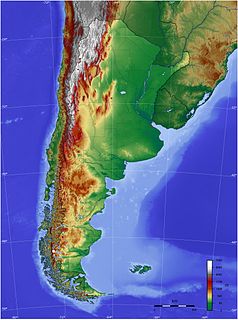
The geography of Argentina describes the geographic features of Argentina, a country located in Southern South America. Bordered by the Andes in the west and the South Atlantic Ocean to the east, neighbouring countries are Chile to the west, Bolivia and Paraguay to the north, and Brazil and Uruguay to the northeast.

The Río de la Plata, called River Plate in British English and the Commonwealth and La Plata River in other English-speaking countries, is the estuary formed by the confluence of the Uruguay River and the Paraná River at Punta Gorda. It empties into the Atlantic Ocean and forms a funnel-shaped indentation on the southeastern coastline of South America. Depending on the geographer, the Río de la Plata may be considered a river, an estuary, a gulf, or a marginal sea. It is the widest river in the world, with a maximum width of 220 kilometres (140 mi).

Club Atlético River Plate, commonly known as River Plate, is an Argentine professional sports club based in the Núñez neighborhood of Buenos Aires, founded on 25 May 1901, and named after the English name for the city's estuary, Río de la Plata. Although many sports are practiced at the club, River Plate is best known for its professional football team, which has won Argentina's Primera División championship a record of 36 times, its latest title the 2014 Final. Domestic achievements also include 12 national cups, with the 2018–19 Copa Argentina as the most recent. Those achievements place River Plate as the most successful team of domestic competitions with 48 titles won in the top division.
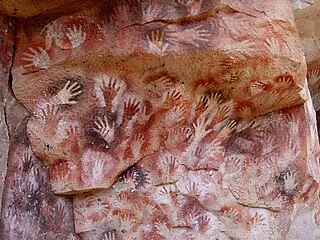
Cueva de las Manos is a cave located in the province of Santa Cruz, Argentina, 163 km (101 mi) south of the town of Perito Moreno. It is named for the hundreds of hand paintings stenciled into multiple collages on the rock walls. The art in the cave dates back as early as 13,000 to 9,000 years ago, to the Archaic Period of South American history, during the Paleolithic era; more specifically, during the late Pleistocene and early Holocene periods. Several waves of people occupied the cave over time as evidenced by some of the early artwork that was carbon-dated to ca. 9300 BP. The age of the paintings was calculated from the remains of bone-made pipes used for spraying the paint on the wall of the cave to create the stenciled artwork of the hand collages. According to Fanning et al., it is "the best material evidence of early hunter gatherer groups in South America".
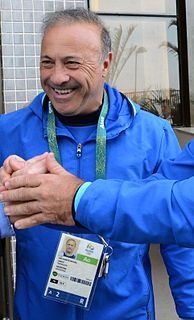
Julio Jorge Olarticoechea is an Argentine former footballer who played as a defender. At international level, he represented Argentina at the 1986 and the 1990 World Cups, winning the former edition of the tournament.
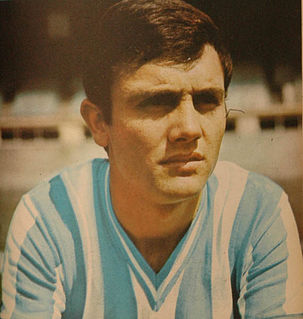
Roberto Alfredo Perfumo was an Argentine footballer and sports commentator. Nicknamed El Mariscal, Perfumo is considered as one of the best Argentine defenders ever. At club level, Perfumo played for Racing, River Plate and Brazilian team Cruzeiro. With the national team, he played the 1966 and 1974 World Cups.

Leopoldo Jacinto Luque (Spanish pronunciation: [leoˈpoldo xaˈsinto ˈluke]; was an Argentine footballer who played as a striker.
Sudestada is the Argentinian name for a climatic phenomenon common to the Río de la Plata and its surrounding region. The phenomenon consists of a sudden rotation of cold southern winds to the south-east. This change, while moderating the cold temperatures, loads the air masses with oceanic humidity, bringing heavy rain and rough seas in the coastal regions. The air circulation also increases the intensity of the winds. The Sudestada is most likely to happen between July and October.
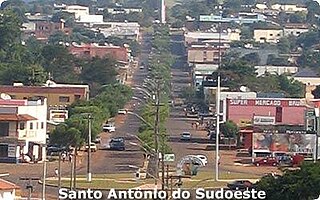
Santo Antônio do Sudoeste is a municipality in the state of Paraná, Brazil with a population of 20,261 inhabitants. It is on the border between Argentina and Brazil, opposite the Argentine city of San Antonio, Misiones. The San Antonio River separates the two cities.
Eastern Bolivian Guaraní, known locally as Chawuncu or Chiriguano (pejorative), is a Guaraní language spoken in South America. In Bolivia 33,670 speakers were counted in the year 2000, in the south-central Parapeti River area and in the city of Tarija. In Argentina, there were approximately 15,000 speakers, mostly in Jujuy, but also in Salta Province, and 304 counted in the Paraguayan Chaco.

Garruchos is a municipality in the western part of the state of Rio Grande do Sul, Brazil. The population is 2,886 in an area of 799.85 km². Its elevation is 69 m by the Uruguay River. It is located 627 km west of the state capital of Porto Alegre, northeast of Alegrete.

Omar Palma is a midfielder. He was born on April 12, 1958, in the city of Campo Largo in the Chaco Province of Argentina. He played most of his career for Rosario Central in Argentina. He was the top scorer of the 1986–87 season with 20 goals in 38 games for Central's championship winning campaign.

Hydromedusa is a turtle genus in the family Chelidae, commonly known as the South American snake-necked turtles. They are quite closely related to the South American side-necked swamp turtles (Acanthochelys) and the snake-necked turtles of the Australian-Melanesian region (Chelodina), but less closely to the spine-necked river turtles of South America (Podocnemididae) which belong to a more modern lineage of Pleurodira.
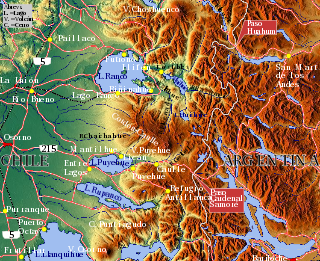
The Huahum River is a river in southern Chile and Argentina. It drains the waters of Lácar Lake in Argentina to Pirihueico Lake in Chile. The river gives name to Huahum Pass, an international mountain pass on the border between Chile and Argentina.
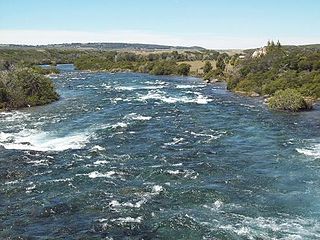
The Palena River or Carrenleufú is a river shared by Chile and Argentina in Northern Patagonia. It drains the waters of the Vintter Lake, also shared by these nations, and it flows into the Pacific Ocean.
Tropidosuchus is an extinct genus of carnivorous archosauriforms from the Middle Triassic period. It is a proterochampsid which lived in what is now Argentina. It is known from the holotype PVL 4601, which consists of partial skeleton. It was found in the Chañares Formation and its type locality is the Chañares River. It was first named by A. B. Arcucci in 1990 and the type species is Tropidosuchus romeri.
The 2017–18 Copa Argentina was the ninth edition of the Copa Argentina, and the seventh since the relaunch of the tournament in 2011. The competition began on 19 January 2018 and ended on 6 December 2018.
The 2018–19 Copa Argentina was the tenth edition of the Copa Argentina, and the eighth since the relaunch of the tournament in 2011. The competition began on 16 January 2019 and ended on 13 December 2019.
The 2019–20 Copa Argentina is the eleventh edition of the Copa Argentina, and the ninth since the relaunch of the tournament in 2011. The competition began on 15 January 2020 and will end in November 2021. On 17 March 2020, the Argentine Football Association (AFA) announced the suspension of the tournament to prevent the spread of the coronavirus COVID-19. After several months the tournament resumed on 23 December 2020.
References
- Rand McNally, The New International Atlas, 1993.
- GEOnet Names Server